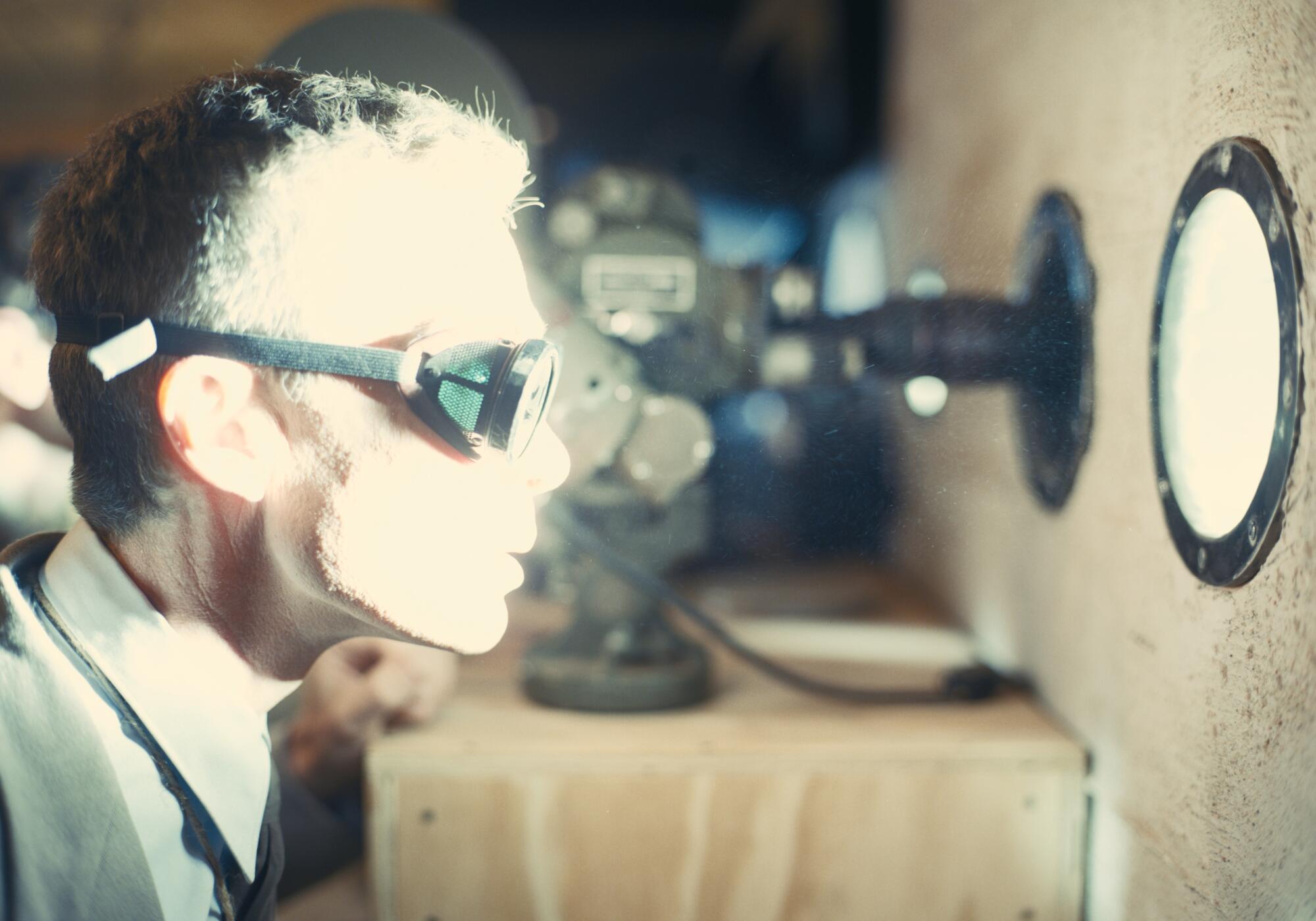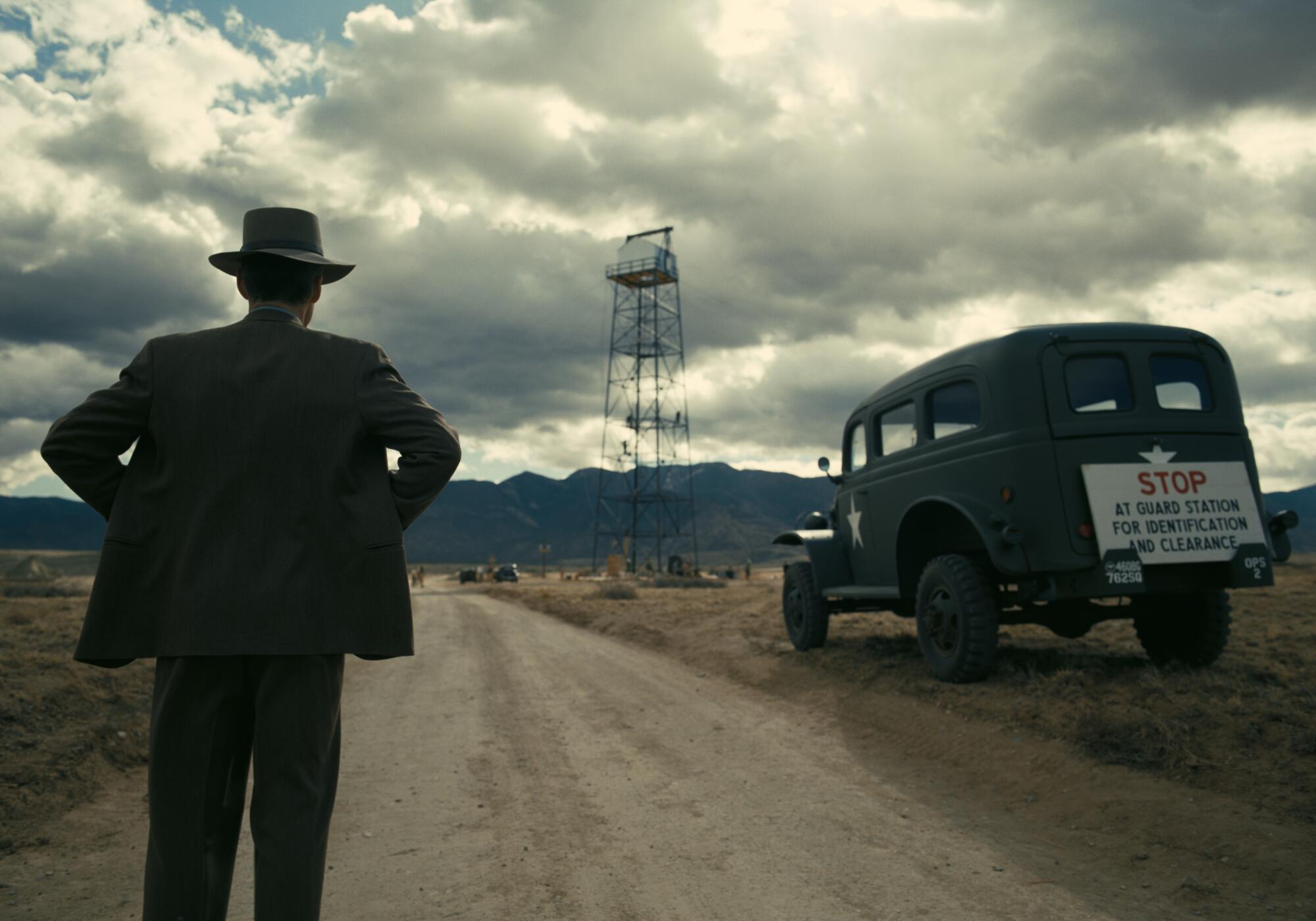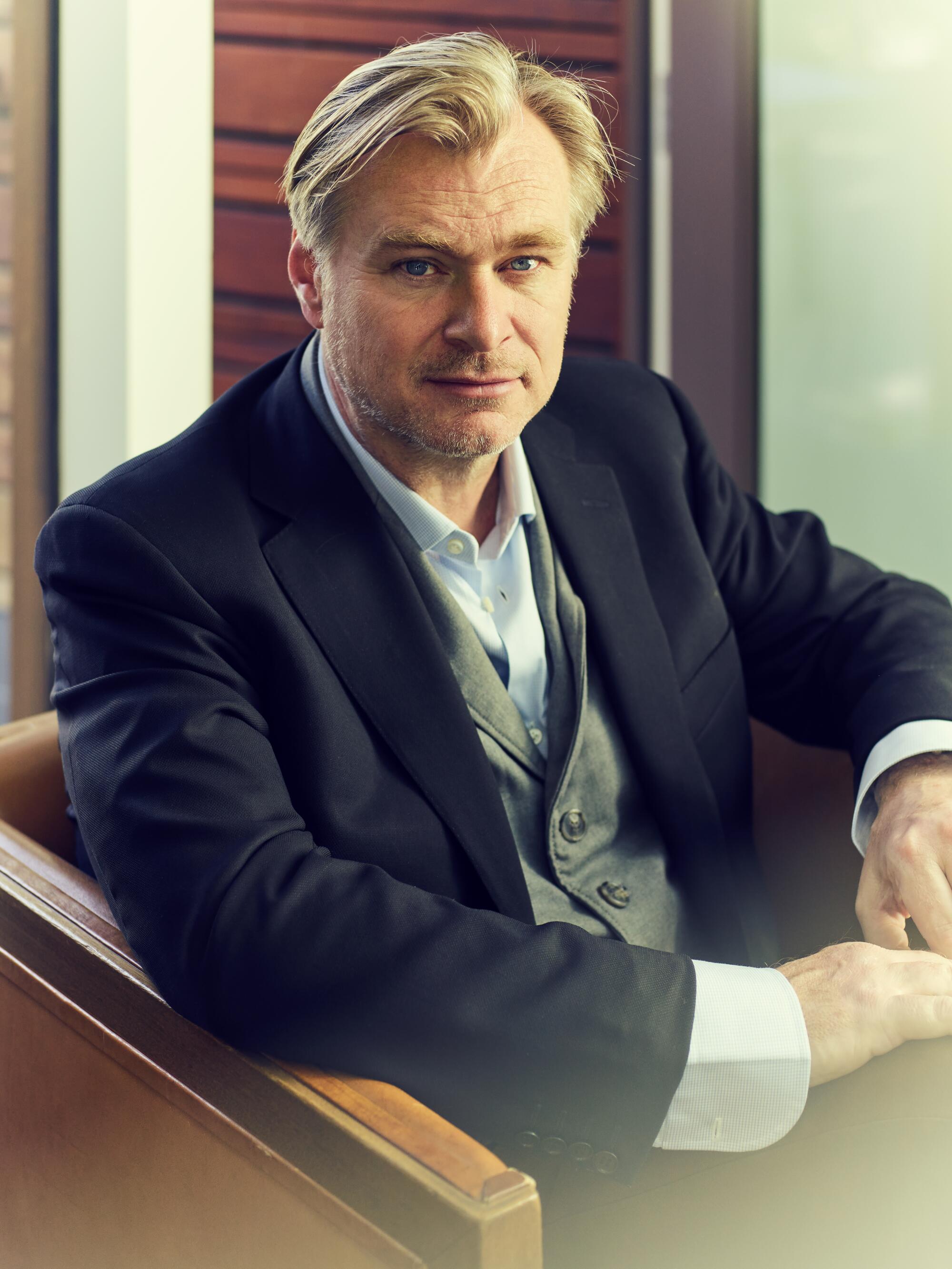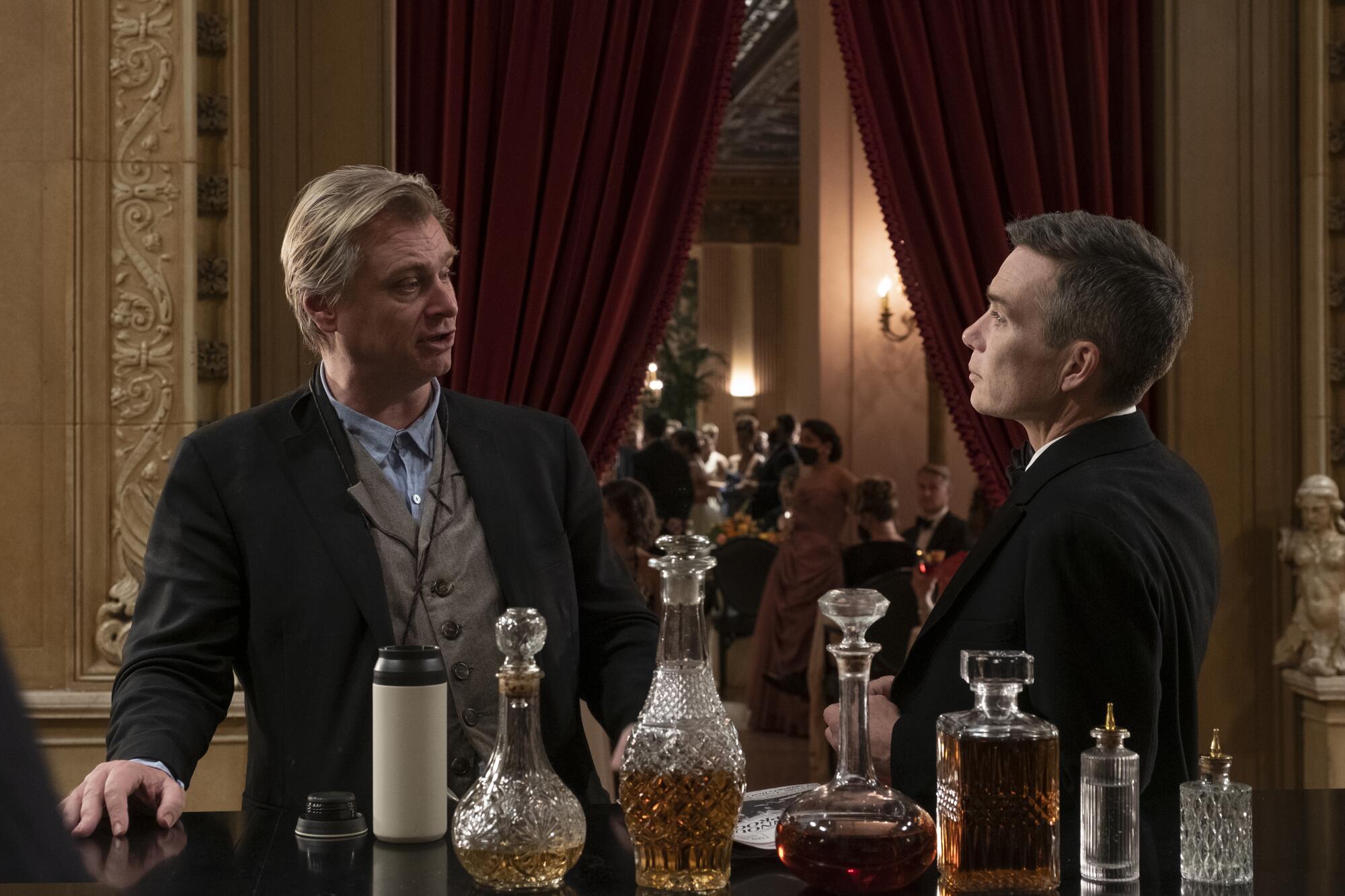- Share via

This is not the story I was supposed to write.
The idea — and it was a good one — was a piece on director Christopher Nolan, not only focusing on his altogether remarkable new film, “Oppenheimer” (set to open July 21) but also examining career parallels between this work and his previous 11 films, which among them have grossed $5 billion worldwide and won 11 of the 36 Oscars they’ve been nominated for.
But, as the Yiddish proverb says, “Mann tracht un Gott lacht,” or “Man plans and God laughs.” Once I experienced “Oppenheimer’s” nuanced examination of the complex, controversial life of the person known as the father of the atomic bomb, someone who went from wartime hero to pariah in what feels like the blink of an eye, those schemes literally exploded.
Arguably Nolan’s most impressive work yet in the way it combines his acknowledged visual mastery with one of the deepest character dives in recent American cinema, “Oppenheimer” demanded to be explored on its own in as much depth as possible.
Which is not to say that parallels didn’t come up in an extended June conversation over cups of freshly brewed Earl Grey tea in Nolan’s office with the director himself, someone equally at ease discussing the literary merits of F. Scott Fitzgerald’s Hollywood writings and the technical complexities of large-format filmmaking. “All the films I’ve made, one way or another, are film noirs,” Nolan proposes. “They’re all stories about consequences. And with ‘Oppenheimer,’ the consequences are the fastest to arrive and the most extreme.”

The movie presents theoretical physicist J. Robert Oppenheimer as the atomic bomb’s essential element, someone whose knowledge, personality and skill set were critical in masterminding the Manhattan Project and creating nuclear weapons, which the director characterizes as “the recurring nightmare, the threat that has never gone away.” Nolan says his personal knowledge of the man had initially been sketchy: He knew the Sting “Russians” lyric (“How can I save my little boy from Oppenheimer’s deadly toy”) and even used his name as a reference in “Tenet.” “It was loose knowledge,” he admits, “that he was instrumental in the bomb and then something else happened, some taint or reckoning.”
This began to change when “Tenet” star Robert Pattinson gave Nolan a wrap present of a book of Oppenheimer’s speeches. This led him to Kai Bird and Martin J. Sherwin’s massive 2005 “American Prometheus,” the 25-years-in-the-making, Pulitzer Prize-winning Oppenheimer biography that became the basis for his script.

Subscribers get exclusive access to this story
We’re offering L.A. Times subscribers special access to our best journalism. Thank you for your support.
Explore more Subscriber Exclusive content.
“Each of my projects suggests itself in a different way,” says Nolan, who often collaborates on the writing with his brother Jonathan (also a director, notably of HBO’s “Westworld”). “Sometimes my brother is busy, and sometimes having a co-writer can be a way of avoiding responsibility. With this, I ultimately collaborated with Kai and Martin, I had their 700 pages. That meant my draft was going to be a shooting draft, which is not the case when I am throwing ideas around with my brother and anything is possible.”
Times entertainment staffers circled these 15 summer movies on their calendars. So should you.
What Christopher Nolan ended up with was a story he describes as “more full of paradoxes and ethical dilemmas than any story I know.” Thinking of films like “Lawrence of Arabia” and “Citizen Kane” as touchstones, he envisioned “Oppenheimer” not as a biography (“a formula that you write into can be creatively stifling”) but more like “a thriller, a heist film, a courtroom drama.”
Not only was Oppenheimer the key player in what one character in the film calls “the most important f— thing to happen in the history of the world,” he was also an extremely complicated individual in his own right, both the smartest person in the room and, Nolan says, someone about whom “it’s impossible to avoid the phrase ‘intellectual arrogance.’ He makes the kind of stupid mistakes only really smart people can do.”
More than anything, Nolan is intent on honoring his subject’s often contradictory impulses, neither fleeing from nor fudging the ruinous difficulties he got himself into, in the scientific arena and in personal and political matters as well.
“We don’t want to judge him, we want to be him, we want to be swept up in his life, to see the world through his eyes,” he says. “In film we don’t often get the opportunity to drill down on these particular moments. Do we know exactly why we do things? Oppenheimer was an extreme form of what we all do.”

Reading “American Prometheus,” Nolan says, “gave me my way in, gave me a structure I could hang complex information on and the confidence I could balance two massively important things, the Manhattan Project and everything that happened after.”
Nolan decided to employ alternating timelines, one shot in color and focusing on Oppenheimer (“I wrote that in the first person”), the other in black-and-white and focusing on Lewis Strauss, chairman of the Atomic Energy Commission and very much Oppenheimer’s bête noire. “They had a Mozart-Salieri relationship, characterized by slights and pride,” Nolan says. “They were two larger-than-life characters.”
To make all this happen, the director first and foremost needed an actor capable of taking on what he describes as “a prismatic presentation of a person’s life.” After “months and months of staring at the biography’s cover” (which features Alfred Eisenstaedt’s intense portrait of Oppenheimer), Nolan realized that uncannily staring back at him was Cillian Murphy, “one of the best actors of his generation,” who’d appeared in five of the director’s previous films, including all three of the Dark Knight Batman epics. “I’ve never seen an actor with such a commitment to the truth,” Nolan says. “But I’d never had him as the lead, so it was a thrill to be able to call him and say, ‘This is the one.’ ”
‘The Trials of J. Robert Oppenheimer’
Good as Murphy had seemed during shooting, Nolan says it was not until he got to the editing suite that “the performance became all-enveloping, when I realized Cillian had so much more going on than I saw on set.” He brings up a parallel situation from one of his earlier films, 2002’s Al Pacino-starring daylight noir “Insomnia.”
“I had gone up to Pacino after a series of takes and given him a note on what I wanted,” Nolan recalls. “He told me, ‘I’ve already done that. You can’t see it to the eye, but I’ve done it on the dailies.’ I looked for it and I was like, ‘Oh, my God,’ because there it was. Great film actors can do that, and that’s what I had with Cillian.”
Also making Oppenheimer a challenge to play was that, as Nolan puts it, “He was so conscious of his iconography, very theatrical and self-aware. It’s too simple to say he was a dandy, but he knew the power of creating an iconic physical image for himself.”

The raffish pork pie hat the scientist almost always wore was so specific (“like Freddie Mercury’s teeth,” the director says) that Nolan finally had to have it specially made. “It was very difficult to build it,” he remembers. “The brim can’t be too stiff or too floppy. It’s like artfully disheveled hair — it takes a lot of fussing, and I often fussed with the hat just before a take.”
The yin to Oppenheimer’s yang, so to speak, was Leslie Groves, the hard-nosed U.S. Army general who’d overseen construction of the Pentagon and hired Oppenheimer to be the head of the A-bomb task force in the built-from-scratch town of Los Alamos, N.M., an appointment that both men knew was very much outside the box.
“Groves had this incredible insight that he should hire the least likely person, a dilettante, a womanizer, a suspected Communist, someone who ‘couldn’t run a hamburger stand,’” Nolan says. “He saw something in Oppenheimer that could make it work.”
Given that “a lot is often made of the negative side of him,” the director’s choice to play Groves, Matt Damon, was also a bit outside the box. “A lot of people found Groves tough, but Oppenheimer loved him, and we’re seeing it from his point of view,” Nolan says. Also, “Matt is as tough as they come, but he also brings charm and charisma, and we shouldn’t ignore the charisma powerful people have.”
To get the maximum visual effect for his upcoming World War II movie “Dunkirk,” Christopher Nolan relied on a $1-million, 54-pound Imax camera that was mounted to the front of a fighter plane and submerged off the coast of France.
If Groves was Oppenheimer’s collaborator, Strauss was his nemesis, and to play him Nolan made an even more unexpected choice — one that works brilliantly. The director picked former Iron Man Robert Downey Jr.
“He’s one of our great actors, and though a generation of kids know what a great movie star he is, they’ve not seen his subtlety and brilliance,” Nolan says. “I wanted to get him to do something completely different, to lose himself in another human being. When was the last time we’ve seen that? ‘Chaplin’? Directors are very aware of how talented Downey is, but because of his incredible energy that can punch through the screen, finding the right thing for him is difficult.”
Also challenging, says Nolan, was the casting of the women in Oppenheimer’s personal life: his wife, Kitty (“very complicated, very controversial”), played by Emily Blunt, and mistress Jean Tatlock (“an obsession of his in a way that is just haunting”), played by Florence Pugh. Of these relationships Nolan admits, “I worried, ‘Can I even get into that?’ It’s so complicated, so important, the backbone of who he is, but it doesn’t fit into any neat dramatic relationship. But things that don’t fit can take on idiosyncratic relationships of their own, they can spike out and become important.”
Another decision the filmmaker made was not to use composite characters but to have each actor onscreen play an actual person. With casting done by John Papsidera, who has worked with the director since his early days with “Memento,” “Oppenheimer” showcases more than a dozen prominent faces, including Rami Malek, Casey Affleck, Matthew Modine and Kenneth Branagh, with Gary Oldman taking a turn as President Harry Truman and — a wild card — “Uncut Gems” writer-director Benny Safdie playing father of the H-bomb Edward Teller. “Because they are playing real people, the actors come in with their own understanding of the characters,” the director says. “They’re bringing their own vision, and the film becomes so much richer.”

“Oppenheimer” is Nolan’s fourth film with cinematographer Hoyte van Hoytema (recently of “Nope”), and, not surprisingly, all of it, even the black-and-white sections (for which Kodak created a new film stock), is shot in 65mm, much of that intended for Imax.
“We associate Imax with giant landscapes, but here Hoyte is shooting faces, eyes, something deceptively simple,” Nolan says. “Whatever Cillian is feeling, thinking, it opens it to the audience. Imax 65mm is the highest-quality image format ever developed, and it allows the screen to disappear. You’re no longer composing frames, you’re following the action. It lets you be right there. It’s 3-D without the glasses.”
As much as possible, Nolan tried to shoot “Oppenheimer” on real locations, for example, using the physicist’s actual house in Los Alamos for interiors. He considered using the Trinity site on New Mexico’s White Sands Proving Ground, where the legendary first atomic bomb test took place, but “because it was still an active military range, it proved too complicated.”
Instead, using a location near Belen, N.M., the director and his team figured out a way to duplicate the look of the blast as a practical (not computer-generated) effect and then “built bunkers and put the actors in the positions of the scientists at the time.”
“I’ve done big explosions before — they are always slightly unnerving, and I knew the Trinity explosion would be so much the extreme of that, the tension for the actors would increase unimaginably. It was thrilling, enervating, an unfathomable sequence,” he added.
As one of the great partisans of the theatrical experience, Nolan is aware that his beliefs can seem “precious,” he says. “But what I do as a director is built on subtleties. You’ve got to choose your battles, and for me, the audience finishes the film.
“Film is an audience medium. You might have ideas, notions, but you don’t know what you’ve done until an audience sees it. Steven Soderbergh once said that while individual members might miss the point, the audience as a whole is the most intelligent response you’re going to get. It’s an audience thing — you’re not just making it for yourself, and you ignore that at your peril.”
Creating movies — what he describes as “a form of artistic expression that works within an industrial process” — has its difficulties, but for Christopher Nolan, this is the place to be. “Cinema has the unique combination of the subjective viewpoint of the novel with the empathetic crowd response of a stage play,” he says. “No other medium can do that.”
More to Read
Only good movies
Get the Indie Focus newsletter, Mark Olsen's weekly guide to the world of cinema.
You may occasionally receive promotional content from the Los Angeles Times.












